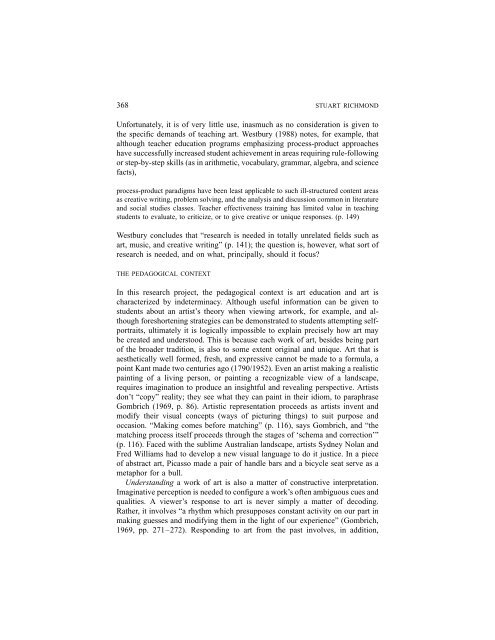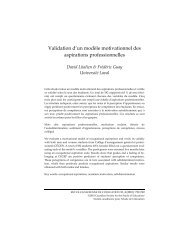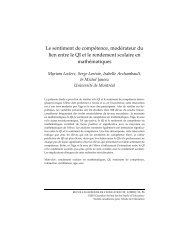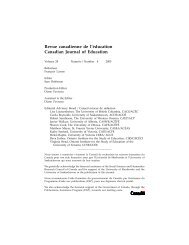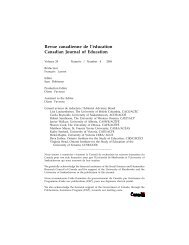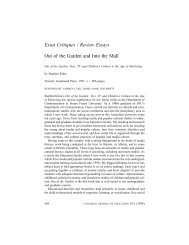Mireille Falardeau et Michel Loranger Le choix de stratégies ... - CSSE
Mireille Falardeau et Michel Loranger Le choix de stratégies ... - CSSE
Mireille Falardeau et Michel Loranger Le choix de stratégies ... - CSSE
Create successful ePaper yourself
Turn your PDF publications into a flip-book with our unique Google optimized e-Paper software.
368 STUART RICHMOND<br />
Unfortunately, it is of very little use, inasmuch as no consi<strong>de</strong>ration is given to<br />
the specific <strong>de</strong>mands of teaching art. Westbury (1988) notes, for example, that<br />
although teacher education programs emphasizing process-product approaches<br />
have successfully increased stu<strong>de</strong>nt achievement in areas requiring rule-following<br />
or step-by-step skills (as in arithm<strong>et</strong>ic, vocabulary, grammar, algebra, and science<br />
facts),<br />
process-product paradigms have been least applicable to such ill-structured content areas<br />
as creative writing, problem solving, and the analysis and discussion common in literature<br />
and social studies classes. Teacher effectiveness training has limited value in teaching<br />
stu<strong>de</strong>nts to evaluate, to criticize, or to give creative or unique responses. (p. 149)<br />
Westbury conclu<strong>de</strong>s that “research is nee<strong>de</strong>d in totally unrelated fields such as<br />
art, music, and creative writing” (p. 141); the question is, however, what sort of<br />
research is nee<strong>de</strong>d, and on what, principally, should it focus?<br />
THE PEDAGOGICAL CONTEXT<br />
In this research project, the pedagogical context is art education and art is<br />
characterized by ind<strong>et</strong>erminacy. Although useful information can be given to<br />
stu<strong>de</strong>nts about an artist’s theory when viewing artwork, for example, and although<br />
foreshortening strategies can be <strong>de</strong>monstrated to stu<strong>de</strong>nts attempting selfportraits,<br />
ultimately it is logically impossible to explain precisely how art may<br />
be created and un<strong>de</strong>rstood. This is because each work of art, besi<strong>de</strong>s being part<br />
of the broa<strong>de</strong>r tradition, is also to some extent original and unique. Art that is<br />
aesth<strong>et</strong>ically well formed, fresh, and expressive cannot be ma<strong>de</strong> to a formula, a<br />
point Kant ma<strong>de</strong> two centuries ago (1790/1952). Even an artist making a realistic<br />
painting of a living person, or painting a recognizable view of a landscape,<br />
requires imagination to produce an insightful and revealing perspective. Artists<br />
don’t “copy” reality; they see what they can paint in their idiom, to paraphrase<br />
Gombrich (1969, p. 86). Artistic representation proceeds as artists invent and<br />
modify their visual concepts (ways of picturing things) to suit purpose and<br />
occasion. “Making comes before matching” (p. 116), says Gombrich, and “the<br />
matching process itself proceeds through the stages of ‘schema and correction’”<br />
(p. 116). Faced with the sublime Australian landscape, artists Sydney Nolan and<br />
Fred Williams had to <strong>de</strong>velop a new visual language to do it justice. In a piece<br />
of abstract art, Picasso ma<strong>de</strong> a pair of handle bars and a bicycle seat serve as a<br />
m<strong>et</strong>aphor for a bull.<br />
Un<strong>de</strong>rstanding a work of art is also a matter of constructive interpr<strong>et</strong>ation.<br />
Imaginative perception is nee<strong>de</strong>d to configure a work’s often ambiguous cues and<br />
qualities. A viewer’s response to art is never simply a matter of <strong>de</strong>coding.<br />
Rather, it involves “a rhythm which presupposes constant activity on our part in<br />
making guesses and modifying them in the light of our experience” (Gombrich,<br />
1969, pp. 271–272). Responding to art from the past involves, in addition,


